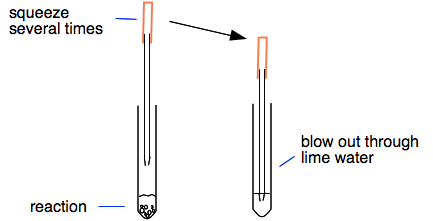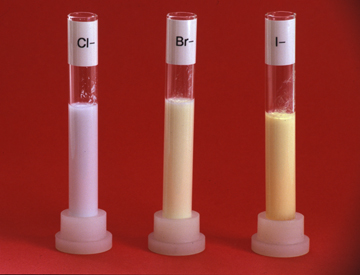|
Chemguide: Core Chemistry 14 - 16 Testing for negative ions This page looks at tests for a number of negative ions - in particular, carbonate, sulfate, chloride, bromide and iodide ions. Testing for carbonate ions Carbonates give off carbon dioxide if you add a dilute acid to them. The acid normally used is dilute hydrochloric acid. Carbon dioxide is given off which turns lime water milky. There is a much easier way of doing this, but I can't find a bit of video which shows it. If you use a dropper to collect a sample of the gas being given off, you can just squirt it out through lime water. It is quick and easy.
This works perfectly well whether your carbonate is a solid or in solution. The ionic equation is the same for all carbonates and all acids.
You should, of course, be ready to write a full equation for any particular reaction if you are asked. In each case, you will get a salt, carbon dioxide and water. The lime water reaction is:
Testing for sulfate ions This is a test done in solution. If you have a solid, you must first dissolve it in pure water before you do anything else. You first acidify the solution you are testing with dilute hydrochloric acid and then add barium chloride solution. If you have a sulfate, you will get a white precipitate of insoluble barium sulfate. | |||||||||
|
Note: Taking samples from bottles using a dropper is a really bad habit to get into. Unless you are scrupulously careful cleaning droppers, you risk contaminating what is in the bottles. It is something I very strongly discouraged when I was teaching! | |||||||||
|
This is a precipitation reaction caused by barium ions and sulfate ions clumping together.
For example, if you add barium chloride to magnesium sulfate, the full equation is:
This takes longer to work out, and to some extent hides what is actually going on. Use the ionic equation unless you are specifically asked otherwise. Why is the acid being added? The acid doesn't seem to be playing any part in this - so what is it there for? Barium sulfate isn't the only insoluble barium compound. Barium carbonate is also insoluble. So if you had a solution of, say, sodium carbonate, that would also give a white precipitate if you added barium chloride solution. The acid reacts with the carbonate ions to form carbon dioxide and water, and so gets rid of them before you add the barium chloride. You have to be careful about what acid you add to do this. For example, you can't use dilute sulfuric acid, because that contains sulfate ions, and so will automatically give a white precipitate of barium sulfate. You can also do this test using barium nitrate solution and dilute nitric acid. A simple way of remembering what acid is safe to use is to choose the one related to the barium compound you are using. If you are using barium chloride solution, you use hydrochloric acid. If you are using barium nitrate solution, you use nitric acid. Testing for chlorides, bromides and iodides This is another test where the substance you are testing has to be in solution, and involves reacting it with dilute nitric acid and silver nitrate solution. The solution you are testing is acidified by adding dilute nitric acid. (Remember: silver nitrate + dilute nitric acid.) The nitric acid reacts with, and removes, other ions that might also give a confusing precipitate with silver nitrate. Silver nitrate solution is then added to give:
The chloride precipitate is obviously white, but the other two aren't really very different from each other. You couldn't be sure which you had unless you compared them side-by-side. All of the precipitates change colour if they are exposed to light - taking on grey or purplish tints. For exam purposes at this level, just learn the colours in the table. For practical purposes, you have to follow up this initial reaction with other tests. | |||||||||
|
Note: If you are interested, the follow-up tests are included on this YouTube video. None of the current UK GCSE syllabus ask for anything more than the initial reaction. | |||||||||
|
The ionic equations for the formation of the precipitates are:
© Jim Clark 2020 |
|||||||||

